


Tradition, Inspiration and Celebration · June 2023 - Sivan/Tammuz 5783 · Published by Chabad Tucson BS”D A JEWISH STRONGHOLD IN SIERRA VISTA WHAT UPLIFTED DR. VIKTOR FRANKL, AUTHOR OF MAN’S SEARCH FOR MEANING Rabbi Benzion Shemtov’s vision for a vibrant Jewish center Calling all singles Netflix Jewish matchmaker is coming to Arizona Father’s Day Memories of loved ones and early mornings Welcome to town Alyssa Katz recently joined U.S. Public Health Service Keeping cool An irreverent guide to surviving summer heat
The Jewish outreach and education network of Southern Arizona
2443 E 4th Street, Tucson, AZ 85719
EXECUTIVE DIRECTOR
Rabbi Yossie Shemtov
REBBETZIN
Chanie Shemtov
OUTREACH DIRECTOR
Rabbi Yehuda Ceitlin
PROGRAM DIRECTOR
Feigie Ceitlin
Affiliates:
Congregation Young Israel, Chabad at the University of Arizona, Chabad on River, Chabad of Oro Valley, Chabad of Sierra Vista, Chabad of Vail and Lamplighter Chabad Day School of Tucson

When envy is a good thing
By Rabbi Yehuda Ceitlin
makes the case that you should have brain envy. While it can be very unhealthy to obsess about others whose status, health, livelihood, abilities, or appearance seems greater than yours, Dr. Amen says you should be envious of others whose brains appear better than yours.
But while he got famous for the concept of brain envy, Dr. Amen hardly invented it.
something we may never be able to attain. But jealousy of another who has refined themselves mentally and spiritually can only inspire us to rise higher.
EDITOR
Rabbi Yehuda Ceitlin
COPY EDITOR
Suzanne Cummins
CONTRIBUTING WRITERS

Feigie Ceitlin, Yossi Feller, Libby Herz, Mordechai Schmutter, Yehuda Shurpin, Benjamin Weiss
PHOTOS
Jacqueline Soffer Studio
SPECIAL THANKS
Chabad.org
EDITORIAL INQUIRIES OR ADVERTISING
Phone: 520-881-7956
Email: info@ChabadTucson.com
Keeping Jewish is published in print periodically by Chabad Tucson and is distributed free in Tucson and around Southern Arizona

Chabad Tucson does not endorse the people, establishments, products or services reported about or advertised in Keeping Jewish unless specifically noted. The acceptance of advertising in Keeping Jewish does not constitute a recommendation, approval, or other representation of the quality of products or services, or the credibility of any claims made by advertisers, including, but not limited to, the kashrus of advertised food products. The use of any products or services advertised in Keeping Jewish is solely at the user’s risk and Chabad Tucson accepts no responsibility or liability in connection therewith.
Note: “G-d” and “L-rd” are written with a hyphen instead of an “o .”This is one way we accord reverence to the sacred divine name. This also reminds us that, even as we seek G-d, He transcends any human effort to describe His reality.
We live in an envy-fueled culture. Just look at what’s popular on social media. People follow those who are more successful, popular, attractive, or talented. They go to work and wish they had the boss’s salary, then they go home and watch sports, where people more fit and talented than them accomplish feats of athleticism far beyond their reach.
Whether we dwell on it or not, envy is a hallmark of modern life — and the technology that made the world small also gave us access to even more people to be jealous of.
But not all envy is harmful.
Bestselling author Dr. Daniel Amen
The Talmud (Bava Batra 21a) says, “Envy among scholars increases wisdom.” While jealousy is prohibited by Jewish law — indeed, it’s one of the Ten Commandments! — when it comes to the study and comprehension of Torah, jealousy is not only permitted but encouraged. Healthy debate and competitiveness sharpen all those involved, win or lose. And looking up to someone wiser, more knowledgeable, or more diligent can inspire us to take after those positive qualities.
The Rebbe — Rabbi Menachem M. Schneerson, of righteous memory — succinctly summed it up in the Hayom Yom: “In material matters, one should always look at those whose situation is inferior to one’s own, and thank the good G-d for His kindness to him. In spiritual matters, one should always look at someone greater than oneself and plead with G-d to grant him the intelligence to learn from the other and the ability and strength to rise higher.”
Jealousy of others’ material success can be toxic, especially if we are seeking
We will soon mark the 29th yahrtzeit of the Rebbe on the third of the Hebrew month of Tammuz (June 22, 2023). The Rebbe led the Chabad-Lubavitch movement that touched millions, yet physically, he lived very simply, eating little and sleeping even less. The Rebbe did not go on vacation and rarely accepted gifts (he turned down a new car purchased by a follower, preferring his decade-old one).
But when it came to spiritual matters, the Rebbe was never satisfied. When someone would approach the Rebbe and boast of some large sum they were donating to charity, the Rebbe would often quote the saying of our sages, “One who has 100 wants 200, and one who has 200 wants 400.” When a rabbi boasted that he prayed with 250 youths at a conference, the Rebbe asked, “And what will be tomorrow?”
This mindset of constantly striving to improve in spiritual matters is something that each of us can take to heart as we walk the paths of life. Then we will surely reach the time when, as Maimonides states, “there will be neither famine nor war, envy or competition …” but instead, “The occupation of the entire world will be solely to know G-d.”
- Rabbi Yehuda Ceitlin is the Outreach Director of Chabad Tucson

| June 2023 | Keeping Jewish
2 OPINION
Netflix’s matchmaker to visit Arizona
Netflix’s acclaimed Jewish Matchmaking show has captured the hearts of viewers worldwide with its unique approach to finding love. Arizona fans will now have the opportunity to delve deeper into the world of Jewish relationships with the show’s host and dating expert, Aleeza Ben Shalom.

Ben Shalom will be bringing her expertise and behind-the-scenes secrets to Scottsdale, Arizona on Sunday, June 11 at 7:00 PM, at The Embassy Suites by Hilton, 4415 E Paradise Village Parkway.

Ben Shalom has years of experience in coa-
ching and matchmaking. She is the author of two books on the subject: “Get Real, Get Married” – a guide to overcoming relationship hurdles and reaching the Chuppah; and “Virtual Dating,” which offers guidance on building connections in a socially distanced world. She has also trained more than 300 dating coaches and matchmakers worldwide.
Ben Shalom, along with her husband and five children, recently fulfilled her lifelong dream of moving to the holy land of Israel. She now resides in the town of Pardes Hanna where she lives with her cherished
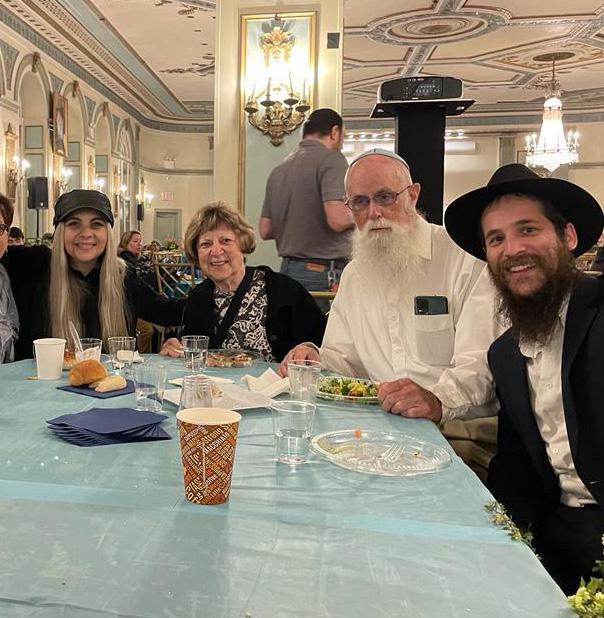
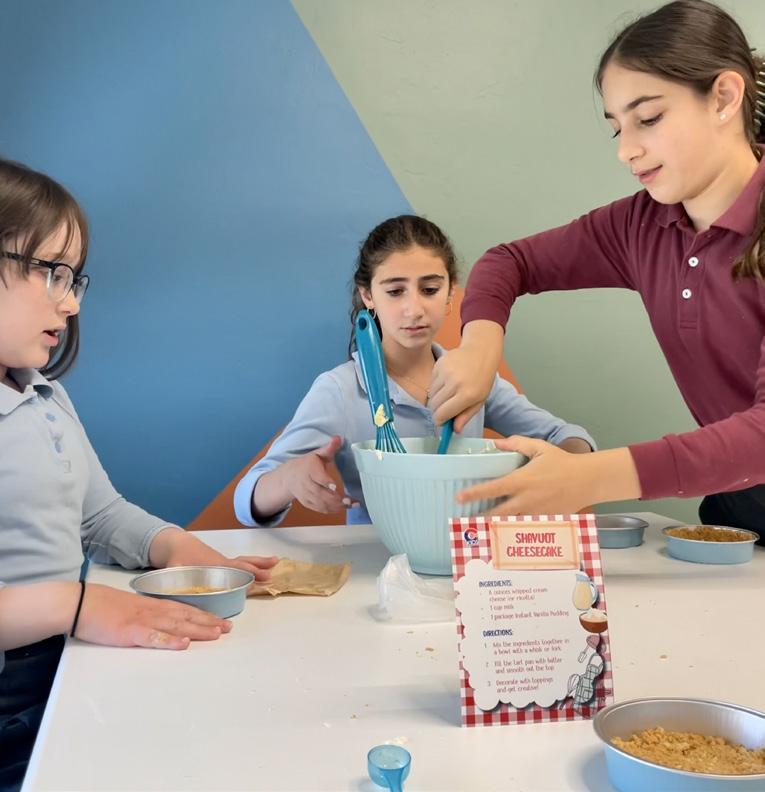
family and their lovable dog, Koda the Kelev.
Organized by Chabad of Paradise Valley and JPhoenix 20s and 30s, the event is open to men and women, both singles and couples. Ben Shalom will discuss the unique issues Jewish individuals face when searching for the right partner, sharing her valuable insights and stories from behind the scenes.
General admission is $36-$72. Tickets are available at jewishparadisevalley. com/5965624
Keeping Jewish | June 2023 | NEWS
3
Drum away. Adults and children partake in a drum circle at Chabad Tucson’s Lag BaOmer celebration
Say cheese. Chana, Sara and Tamar, students of Lamplighter Chabad Day School of Tucson, create their own cheesecake in honor of the holiday of Shavuot
Shabbat in the Heights. Rabbi Ephraim Zimmerman (right) and members of Chabad of Oro Valley spent an uplifting weekend in Brooklyn’s Crown Heights neighborhood
A JEWISH CENTER FOR SIERRA VISTA
Rabbi Benzion and Chaya Shemtov build a community in Cochise County
Sierra Vista is a town nestled in Cochise County and surrounded by the breathtaking landscapes of southeastern Arizona. It offers birding, outdoor adventure, astronomy, and amazing mountain views. Rabbi Benzion Shemtov wants it also to be known for having an active Jewish community, even if small and dispersed.
Since arriving in 2016, Rabbi Shemtov and his wife Chaya have been running Jewish services and programs based out of their home and various other locations. On Chanukah, for example, Rabbi Shemtov travels with a life-size Menorah to celebrate in the cities of Benson and Bisbee and also holds activities and clerical visits in Douglas, Tombstone, and Wilcox.
Alla Bernshtein, a Sierra Vista resident, joined a Chanukah celebration after seeing the large menorah at an event. She has been involved with the Chabad of Sierra
By Libby Herz
Vista ever since.
“Both of my kids were born here in Sierra Vista,” Bernshtein says. “The Shemtovs have been welcoming and very helpful in enhancing our Jewish life here. We connect about the High Holidays and other events throughout the year, and they were there for both of my son’s brit milah.” She credits Mrs. Shemtov with going “above and beyond” and making all the necessary ceremony arrangements for the Brits.
“She put her heart and soul into it, and it showed. I am beyond grateful for their presence.”
Leonard Chyet, a U.S. Army veteran who lives in the nearby town of Dragoon, shares a similar sentiment. “I’ve never felt more Jewish in my life since meeting the rabbi,” Chyet says. “I am a strong proponent of what Rabbi Shemtov has brought to Cochise County,” he adds, noting how he looks forward to the rabbi’s visits when
they pray together and study Torah.
New phase
Bernshtein and Chyet are two of the many Jewish residents of the county who are looking forward to the next phase of the local Chabad.
The Shemtovs have recently launched a capital campaign for a Jewish Center, dubbed “A Jewish Stronghold for Cochise County.” A 3,781-square-foot building that is centrally located on East Fry Blvd., right near affordable housing and motels, promises to be a gathering place where all Jews will be welcomed to celebrate and exult in their Judaism.
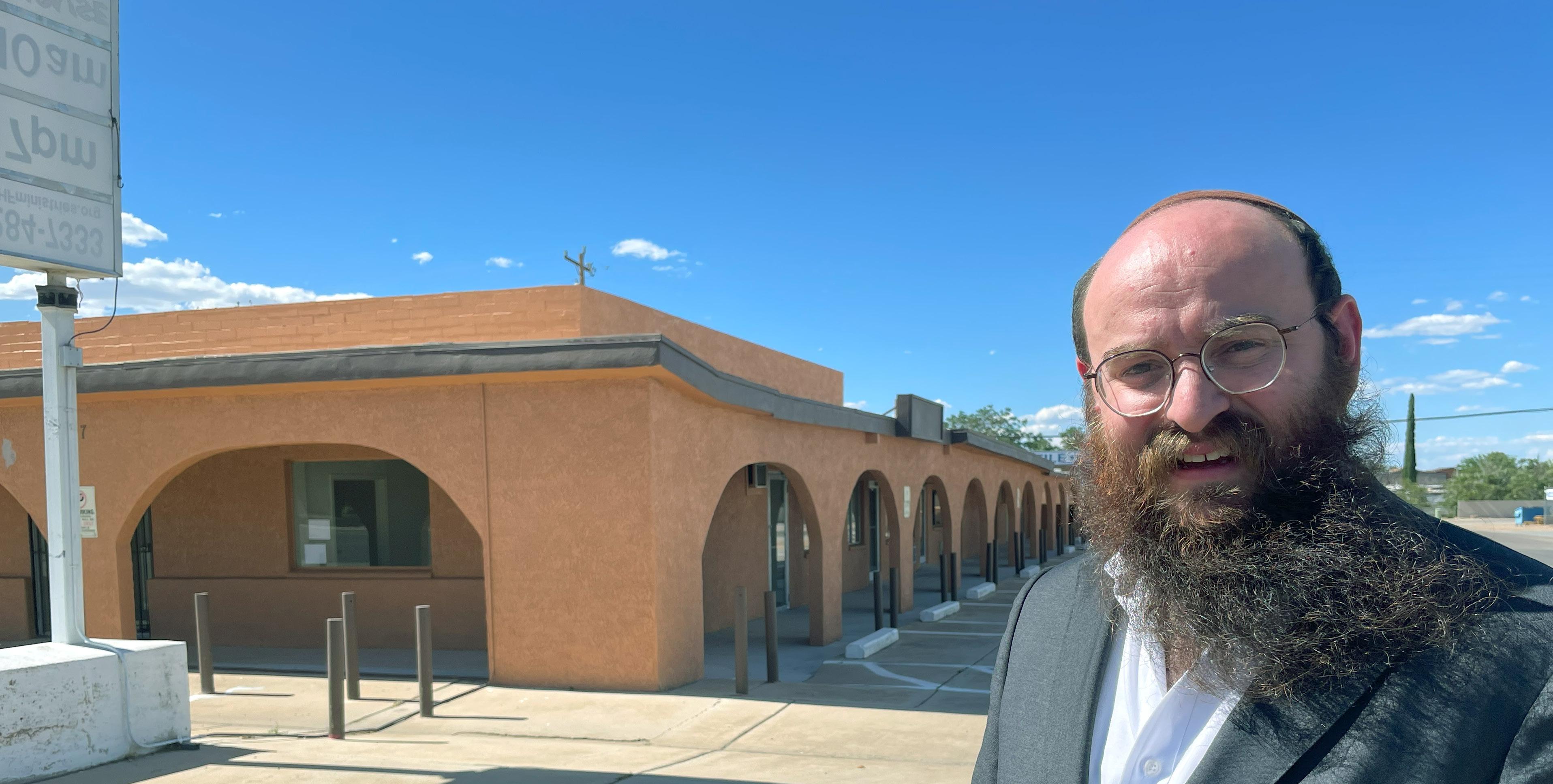
“We will be able to have a location we can call home,” Bernshtein says. “People will know that this is Chabad.” The building will include space for services, classrooms, a social hall, a library, and the only kosher
commercial kitchen in the county.
Retired Bisbee priest Joe Saba, who spearheaded a fundraising drive For St. Patrick Roman Catholic Parish’s stained glass window restoration project, is happy about the development of Chabad.
“I think what the rabbi has done is wonderful,” he told the Sierra Vista Herald/Review. “The more centers of faith a community has for its members of diverse beliefs and religions, the better it is for a community. It makes it a more tolerant, unified place.
“We need more open places of different denominations where people can come to worship. I don’t personally know the rabbi, but what he has done by establishing a permanent temple in Sierra Vista is wonderful. I couldn’t be happier for him and the Sierra Vista community.”
| June 2023 | Keeping Jewish
4
Rabbi Benzion Shemtov in front of the new center for Chabad of Sierra Vista
Not everyone was initially enthusiastic about the location of the center in the heart of town.
Brooklyn-born Barry Levitt, the founder and owner of Sierra Cycles in Sierra Vista, had his doubts. “I said, ‘Rabbi, Why do you want to be right there in town? Land can be so much less expensive two miles away.”
Levitt admits, “The rabbi has made a huge change in my life for the good.” Before getting involved with Chabad, Levitt wasn’t very connected with his Judaism. Now, he dons Tefillin, learns Torah weekly, and attends services.
He has since visited the proposed new location of Chabad and is now on board. “The rabbi’s whole perspective is to be there for the Jewish community where it’s most dense so people can walk there. He has a goal in mind which is everlasting for the community from youth all the way up to the whole lifetime.”
Family assignment
Rabbi Benzion Shemtov is the son of Rabbi Yossie and Chanie Shemtov, who founded Chabad Tucson in 1983 at the instruction of the Rebbe, Rabbi Menachem Mendel Schneerson, of blessed memory. “I grew up in the glow of my parent’s dedication to the Jewish community in Tucson,” says Benzion. “It was my dream to move back and serve a nearby community.”
In 2013, Rabbi Benzion married his wife Chaya. She was born and raised in a Chassidic Jewish family in Montreal, Canada. After high school, she volunteered and worked as a camp counselor and teacher in Montreal and in St. Thomas for Chabad Lubavitch of the Virgin Islands. She had found a passion to serve and educate.
The young couple originally settled in the bustling Jewish community of Crown Heights in Brooklyn. But they regularly canvassed the map of Arizona, looking for an area that needed Jewish infrastructure. They finally came upon Sierra Vista, a military town with many retirees 80 miles southeast of Tucson.
“I noticed that people in Sierra Vista who
wanted to engage with Judaism were commuting an hour and twenty minutes to Tucson,” says Rabbi Shemtov. With the blessing of his parents and Rabbi Zalman Levertov, Regional Director of Chabad of Arizona, the young Shemtovs moved to Sierra Vista and got to work.
They first offered a Rosh Hashana prayer service at their home with a borrowed Torah scroll and hosted locals for holiday and later Shabbat meals and celebrations. They later launched a monthly Tefillin club for men and a Jewish women’s society.

Rabbi Shemtov soon became the contracted rabbi at the United States Army installation of Fort Huachuca, where he leads a weekly prayer service and Torah class for military personnel.
When the Covid-19 pandemic hit, the emerging community hit a snag. “After three years of work, everyone stopped coming,” Rabbi Shemtov recalls. “We felt like we were starting again. It was a struggle, but we remained undeterred.”
Rabbi Shemtov continued looking after individual Jews throughout the pandemic and since. “With all the things he’s got to do and to purchase this new synagogue, the rabbi makes it his business to see if I’m ok,” says Chyet. “That’s never happened to me in my life! He is an incredible man. He drives to my house, and I don’t live around the corner. It’s an hour’s drive!”
Rabbi and Mrs. Shemtov offer a Sunday Jewish school where their own children have an active role. Their eldest daughter Goldie (9), assists with the Aleph Champ Hebrew reading program, and on Shabbat, their children help set up the Kiddush meal. “Serving dessert is their favorite part,” Mrs. Shemtov says with a smile.
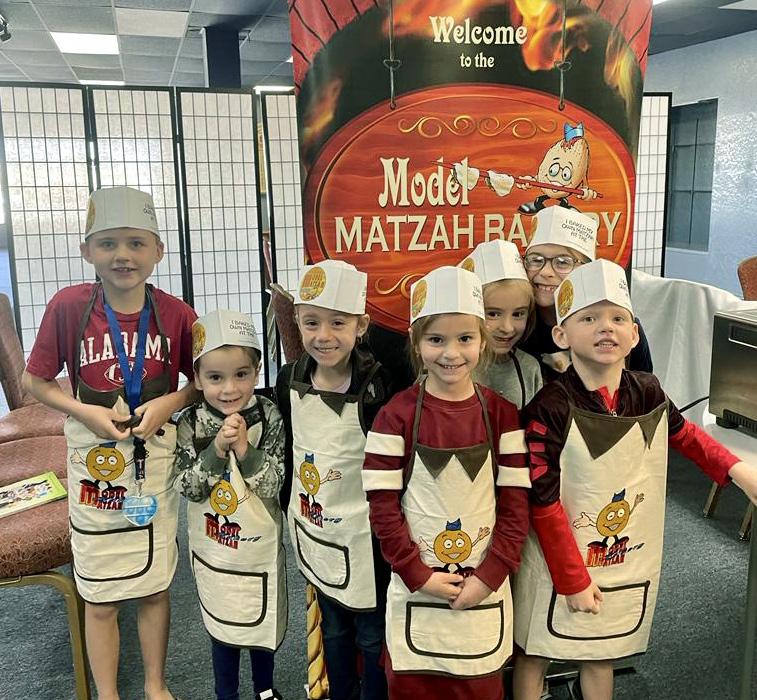
The Shemtovs say they are eager to be able to spend time with people in the new building. “As much as we encourage people to do Jewish things at home, you really feel Jewish once you join a community,” Rabbi Shemtov notes. “Having this building will help people enjoy that great connection.”
To support the new center, visit: www. Jewishsierravista.com/stronghold
Keeping Jewish | June 2023 | 5
An art class during a Jewish women’s circle at Chabad of Sierra Vista
Children participate in a Model Matzah Bakery at Chabad of Sierra Vista
FOUR WAYS TO USE YOUR HEAD
By Yanki Tauber

Which types of learning are truer, purer, more useful, more important—the things we know with our bodies or the things we ponder inside our brains? Academics and basketball coaches have been debating the question for centuries, and it’s unlikely to be resolved in another 1,000-word polemic.
But perhaps we’re asking the wrong question. Maybe the question is not whether theoretical knowledge is superior or inferior to hands-on learning but whether the two must co-exist. *
Three people are talking in a doctor’s waiting room.
“This is my body, my life,” says Patient #1. “Just because the guy has a diploma hanging on his wall doesn’t mean that I’m going to blindly follow his instructions. I’m going to do my own research. I’m not doing or taking anything until I’m convinced that that’s the best way to go...”
“Let’s face it,” counters Patient #2. “It may be my body, but right now, the guy behind that door knows more about it than I do... I’m going to educate myself about my illness, but that will take time. Until I acquire that knowledge, I’m best off following the doctor’s instructions.”
“The guy behind that door spent eight years studying to be a doctor,” opines Patient #3, “and another twenty-five years treating people in our condition. You think I’ll ever acquire that kind of knowledge googling the internet? I’d just be wasting my time. I’m going to follow the doctor’s instructions and leave the thinking to him... That’s his job!”
Three ways to be a patient. Three ways to be a husband, a wife, a parent, a neighbor, or business person. Do I defer to those who know better? Do I try to figure it out on my own? Or do I adopt a two-step approach, beginning by following those with superior knowledge and expertise until my own
knowledge and expertise take over?
Three ways to live a life. Or is there perhaps a fourth way?
Patient #4 speaks up: “Patient #3 is right — no matter how much I research and educate myself, the doctor will still know more than me. So I’m going to listen to him, certainly now when I know next to nothing, and also later, after I’ve learned all that I can...”
“But if you’re going to follow the doctor’s instructions anyway,” Patient #3 interjects, “why bother to study and learn? What’s the point?”
| June 2023 | Keeping Jewish
JUDAISM 101
6
Understanding the Mitzvah of wearing Tefillin
Photo by Aleks from Pixabay
“Because, like Patient #1 says, it’s my body and my life. I need to understand what I’m doing and why I’m doing it...”
“So it’s just to make you feel better about the fact that you’re submitting to a higher authority?” challenges Patient #1.
“It’s not just that. Despite my deference, I am an active partner in my cure. The doctor needs me to be asking the right questions, and giving feedback about my own experience in the medical context. It is a partnership.
*
The tefillin are a pair of leather boxes, one worn on the arm opposite the heart, and the second worn on the head above the hairline aligned with the space between the eyes. Inside the boxes are parchment scrolls inscribed with four Torah sections (Exodus 13:1-10; Exodus 13:11-16; Deuteronomy 6:4-9; Deuteronomy 11:13-21) containing the fundamentals of the Jewish faith.

The arm and the head are the two basic instruments of life: action and knowledge. The tefillin represent the “binding” and dedication of these instruments of life to serve G-d.
Numerous laws govern the making of the tefillin and how they are worn. The Chassidic masters teach that each Torah law has both a body and a soul — a practical instruction and an inner significance. So the laws of tefillin can be understood on two levels: as a set of instructions on how to make and wear tefillin; and as a thesis on the nature of mind and deed, their relationship to each other and the manner in which they serve our mission in life.
One of the laws of tefillin concerns the order in which they are put on and removed: first we bind the tefillin on the arm, then we place the tefillin on the
head. In removing the tefillin, the order is reversed: first the head-tefillin are removed, and then the arm-tefillin. This law is derived from the verse, “and they shall be as tefillin between your eyes.” (Deuteronomy 11:18). Emphasizing the plural form of the word vehayu--”and they shall be”--the Talmud understands the verse to imply, “at any time that there is tefillin between your eyes, there shall be both” (Talmud, Menachot 36a).
In other words, there may be times and situations in which you’re wearing only the arm-tefillin--i.e., before you put on the head-tefillin or after you removed it —but
never a time or situation in which the head-tefillin are being worn without the arm-tefillin.
We are taught four basic truths about the interplay between mind and action:
1) We need both.
We cannot say, “I trust G-d. I’ll follow His commands. I don’t need to understand.” Nor can we say, “The important thing is to understand what G-d is telling us with all these commandments about Himself, about life in general. Actually doing them—well, if it does something for you, fine, but that’s not what it’s about.” Our relationship with
G-d should encompass our entire being— mind as well as deed, action as well as thought. That’s why there are two tefillin-one for the arm and one for the head.
2) Doing comes first.
The basis and foundation of our lives are the mitzvot—the divine commandments. Saying, “I won’t do it until I fully understand,” is like refusing to take the medicine the doctor has prescribed until you understand exactly how antibiotics are made and how they neutralize bacteria, or refusing to breathe until you’ve studied how the lungs function and why your body requires oxygen.
3) Commitment and deed transcend understanding.
Even after we’ve studied and understood, to the full extent that we are able, there will still be times and situations when we don’t fully understand and need to simply obey and trust the wisdom of our Creator. We need to be able to say to ourselves, “This is what I understand, and it has made my doing that much more meaningful. But there’s more to life than what I can understand.
4) There cannot be knowledge without action.
This is expressed by the axiom, “At any time that there is tefillin between your eyes, there shall be both.” While it may be the case that we are enwrapped in the arm-tefillin without the head-tefillin (either because we have yet to attain full understanding or because we’ve advanced beyond it), the reverse is never the case. In other words, there’s no such thing as “theoretical knowledge.” Thought that is uncoupled from action understands nothing at all.
Knowledge adds depth to our doing. Doing is what makes our knowledge real.
Keeping Jewish | June 2023 |
7
- Rabbi Yanki Tauber is the chief writer and editor of The Book, a new translation and anthologized commentary for The Five Books of Moses.
Photo by Benjamin Nunez Gonzalez
Alyssa Katz grew up in Akron, Ohio, where her family still lives. She did her undergraduate degree at Johnson & Wales University in Providence, Rhode Island, and her Master’s at Saint Louis University. She studied culinary nutrition and is now a dietitian.
She was recently instated as an officer with the Commissioned Corps of the U.S. Public Health Service under the direction of the Surgeon General of the United States. She is contracted with the Indian Health Service and serves at the Sells Indian Hospital in the district of the Tohono O’odham Nation as a dietitian.
Moving to Tucson: I have been in Tucson for a little over a month. Before this, I was living in Detroit, Michigan, for 3 years. The sun and weather are incredible here, but I hear it’s going to
Welcome to town: Alyssa Katz
By Benjamin Weiss
get very HOT! So far, I have enjoyed the views and nature in Tucson.
Currently reading/learning: Positivity Bias - Practical Wisdom for Positive Living, by Mendel Kalmenson. It teaches about trying to look at situations in a positive light.
Favorite Mitzvah/holiday: Rosh Hashanah - the new year, delicious food, and family. It also feels refreshing.
Cherished Jewish memory: There are too many to count. Most recently, it would be bringing the Detroit community together through my time at the Moishe House to have Shabbat or other holiday events.

Jewish app on phone: NCSY Bencher (for blessings and Jewish
songs), but I am always taking other suggestions.
Go-to Yiddish or Hebrew word: Oy vey (Yiddish for oh no).
Historical Jewish figure: Miriam from the Torah.
Define Chabad: A place for community and learning.
Define Tzedakah: To give to others who need it more, and to pay it forward.
Define Happiness: Living life to the fullest and enjoying it along the way.
Hobbies:
Cooking, eating and drinking. Exploring the
city, lifting weights, hiking and biking.
Comfort food: Ice cream or chocolate.
Kvetch:
I used to complain about the cold, but maybe those days are over...
Kvell / nachas:
I feel nachas with my family, who are so far away but thank goodness for modern communication.
Your claim to fame: An abundance of energy.
Something you’re looking forward to… I moved to Tucson by myself, so I am looking forward to meeting the community, building community, and seeing what Tucson has to offer.
| June 2023 | Keeping Jewish 8
Alyssa Katz (center) with close relatives at her officers’ graduation ceremony
LOCAL
Classic homemade Israeli hummus
By Feigie Ceitlin
With its rich history and delightful flavors, hummus has become a beloved dish around the globe. Using a traditional preparation of Israeli hummus, this homemade recipe captures its authentic taste and creamy texture.
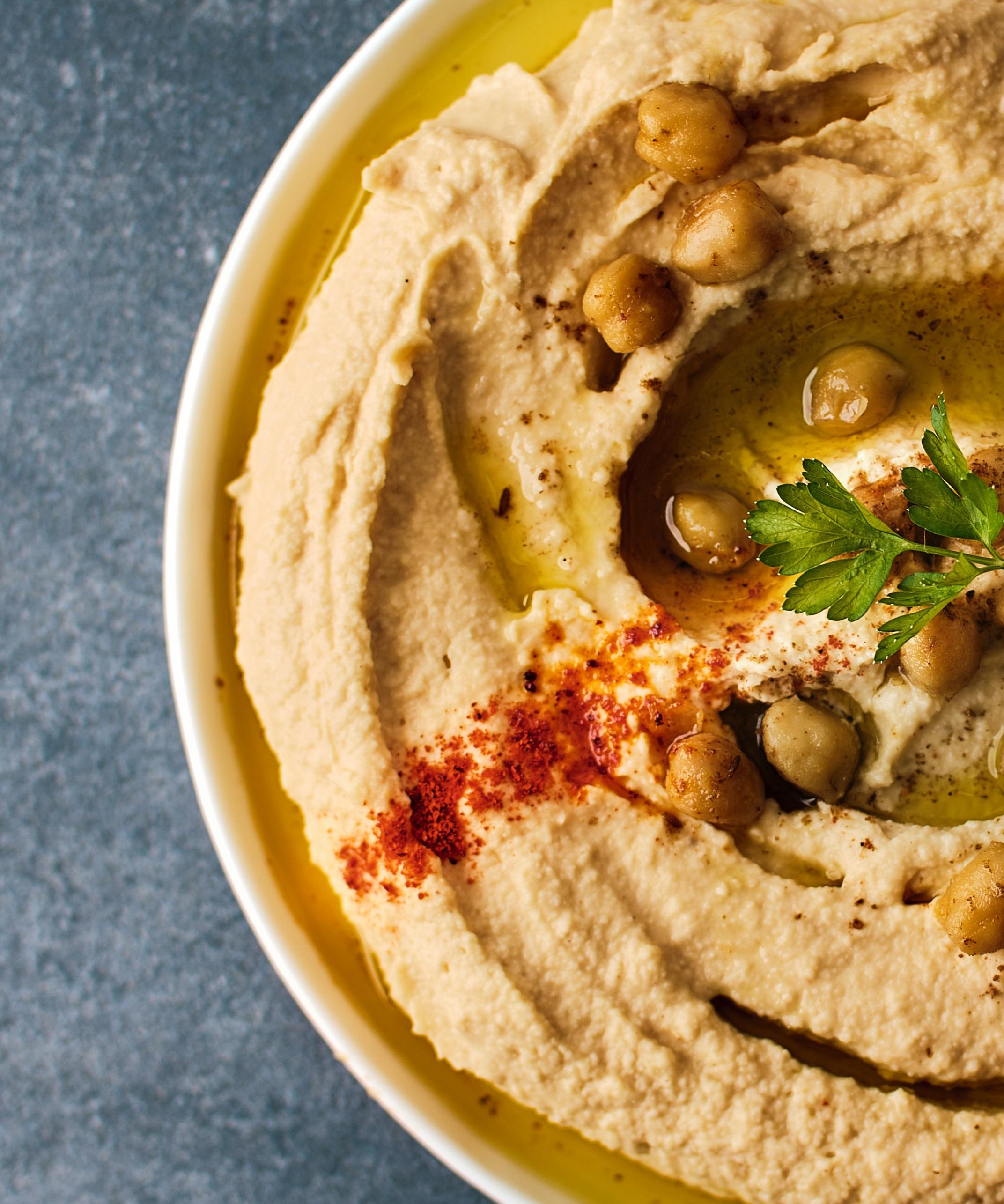
It is based on the recipe of Michael Solomonov and Steven Cook in their excellent cookbook, “Israeli Soul: Easy, Essential, Delicious.” Let’s dive into the recipe and discover the art of making hummus from scratch, bringing the taste of Israel right to your table.
INGREDIENTS:
1 clove garlic
Juice of 1 lemon
1 16 oz jar of Tehina
1 T kosher salt
1 tsp cumin
1- 1 ½ cups ice water
2- 15 oz cans of chickpeas drained and rinsed
DIRECTIONS:
1. Begin by rinsing and draining the cooked chickpeas. If you’re using canned chickpeas, make sure to thoroughly rinse them to remove any excess sodium and improve the texture of the hummus.
2. Combine garlic, lemon juice, tahini, salt, and cumin in a food processor or high-powered blender. Process on high for about 1 minute until it kind of looks like peanut butter.
3. Slowly drizzle the ice water until the texture turns to a light sand color.
4. Once that is super smooth, add the drained chickpeas and process for about 3-5 minutes - until super smooth.
5. Once the hummus reaches your desired consistency and taste, transfer it to a serving bowl.
6. To garnish, drizzle a little extra virgin olive oil over the top of the hummus. Sprinkle paprika for a hint of color and flavor. You can also add a few cooked chickpeas or fresh parsley leaves for a vibrant touch.
7. Serve the Israeli hummus with warm pita bread, fresh vegetables, or your favorite dipping accompaniments. It can also be used as a spread in sandwiches or as a flavorful addition to salads.
*
The blessing: Shehakol
Baruch atah A-donay, Elo-heinu Melech
Ha’Olam shehakol nihiyah bed’varo. Blessed are You, L-rd our G universe, by Whose word all things came to be.
B’Tayavon!
— Rebbetzin Feigie Ceitlin is the program director of Chabad Tucson and head of school of Lamplighter Chabad Day School.


KOSHER
Photo by Ludovic Avice / Unsplash
One of the most startling examples of the vision of the Rebbe, Rabbi Menachem Mendel Schneerson, was brought to my attention during my service in Vienna. It involved the famed psychiatrist Dr. Viktor Frankl, the Holocaust survivor who became the founder of logotherapy and author of the classic Man’s Search for Meaning.
From the first year we arrived in Vienna to lead Chabad-Lubavitch institutions, before Rosh Hashana, we would send a Hebrew calendar to all the Jewish families in the area. And every year, Dr. Frankl would send us a humble donation in return.
It was a mystery to me why he chose to donate specifically to Chabad, a religious organization dedicated to teaching Judaism, when he himself was not active in any Jewish community. I did not inquire, however, and the mystery was only solved many years later.
In 1994, I received a visit from an elderly woman who identified herself as Marguerite Chajes, who greeted me with, “I have a surprise for you. You might think that you are the Rebbe’s first emissary in Austria, but you are not. I was the first.” I was indeed surprised to hear that, but then
The Rebbe’s impact
How a message of encouragement transformed Dr. Viktor Frankl’s journey
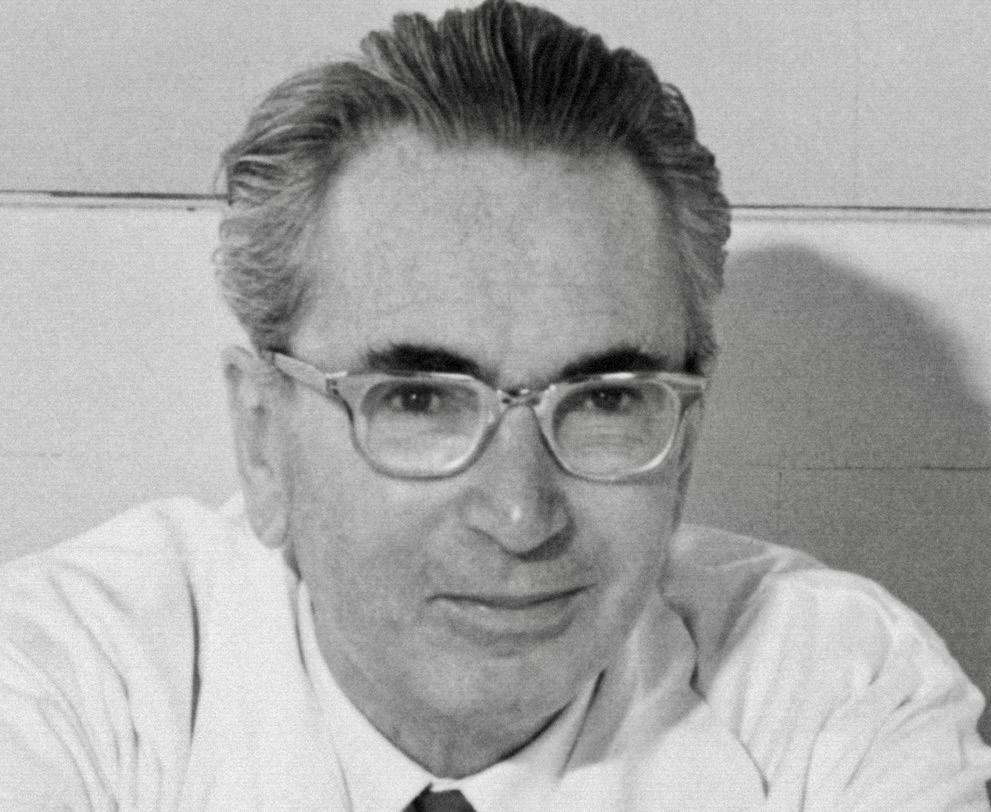 By Rabbi Yaakov Biderman
By Rabbi Yaakov Biderman
she explained what she meant.
In 1958, during an audience with the Rebbe, she mentioned that she wanted to visit Austria, where she had been raised and fled before the war started. Hearing this, the Rebbe asked her to contact his office before her trip, as he had a particular mission for her.
A few months later, when she was ready to go, she did this. The Rebbe’s secretary told her she was to contact a Dr. Viktor Frankl in Vienna and relay a message to him in the Rebbe’s name: “Don’t despair. Don’t take any of the ridicule you are facing to heart. Continue to disseminate your teachings. Be strong.” And the Rebbe sent his blessings for success.
Now I need to explain that, at that time, Dr. Frankl was not yet the famous professor he would later become. He had studied with Sigmund Freud before the war, but after his experiences in the Nazi concentration camps, where his whole family was murdered, he departed from the Freudian view. He concluded that man’s deepest drive is not toward pleasure but towards meaning. Indeed, man is always searching for meaning in life - even in the
most dehumanizing situations- and mental health is very much related to faith and values. This conclusion served as a basis for his form of existential analysis, which he called logotherapy.
But this flew in the face of the accepted notions of the day.
And although he was appointed to head the prestigious Vienna Polyclinic of Neurology after the war, his ideas were subjected to tremendous ridicule by proponents of Freudian psychoanalysis, which was mainstream. People would even heckle him in the middle of his lectures. This reaction hurt him so much that when Marguerite came to search for him at the clinic, she was told that he hadn’t come to the office in a while. So she went to his home.
She told me that, when she arrived, she was surprised that the woman who opened the door and identified herself as Dr. Frank’s wife did not appear Jewish at all and that a crucifix was hanging on the wall. She thought it was very odd that the Rebbe would send her to encourage someone like that. (Only later did she learn that, after the Holocaust, Dr. Frankl had married a devout Catholic woman and that
the crucifix obviously belonged to her.)
Nonetheless, Marguerite was determined to fulfill her mission, and when Dr. Frankl appeared, she told him that she had a message for him from the Lubavitcher Rebbe. He invited her to sit down, and she said, “Rabbi Schneerson asked me to convey to you that you should not give up. Be strong. Don’t be embarrassed by those who ridicule you. Continue on your path. You will prevail.”
His response to those words shocked her. She said that she had never before seen an adult - never mind a personality of Dr. Frankl’s stature - break down in such bitter tears. It took him some time to compose himself, and then he showed her the papers that were lying on the table - they were immigration documents for Australia. He was so crushed by the treatment he had suffered that he decided to leave Vienna. But after absorbing this message from the Rebbe, he felt encouraged. He told her, upon parting, “I will find the strength to return to my work. I will continue.”
Shortly thereafter, he published the English version of his book, A Psychologist Experiences the Concentration Camp,
| June 2023 | Keeping Jewish
STORY
HISTORY
10
Dr. Viktor Frankl photographed in 1965 * Photo: Franz Vesely
determined Frankl to up. those path. her. Dr. bitter they Australia. had Vienna. the to Psychologist

under the title Man’s Search for Meaning. It became a huge bestseller, which has sold over sixteen million copies, and has been translated into two dozen languages.
This was such a remarkable story - that the famed Viktor Frankl might not have had the impact he’d had on the world were it not for the Lubavitcher Rebbe! - that I needed to confirm it. I decided to meet Dr. Frankl myself. He was very old by then, nearly 90; still, I took a chance and called him. He answered the telephone himself but said he was weak and could not meet me. He sounded impatient, and it was clear he was not well. Nonetheless, I asked him, “Does the name Lubavitcher Rebbe or Rabbi Schneerson mean anything to you?”
The moment that he heard the Rebbe’s name, his tone changed completely. “Certainly, certainly, the name Rabbi Schneerson means a lot to me. I owe him a great deal, he said to me in German. “I respect the Rebbe very much. He helped me at an extremely critical moment. I owe him a great deal.”

And, indeed, so do many others. Millions of people benefitted from the Rebbe’s message to Dr. Frankl. I cannot imagine what would have occurred if not for the Rebbe’s
perfectly-timed words of encouragement.
But I have also wondered what led the Rebbe to take an interest in Viktor Frankl in the first place. As far as I know, Dr. Frankl had never communicated with the Rebbe, yet the Rebbe took pains to encourage him and support his work. It would seem that the Rebbe did this not only out of personal concern for Dr. Frank’s welfare but also to advance a philosophy that he felt ultimately fosters a belief in G-d, a spiritual perspective, and good values. The fact that this constitutes the real cure for a suffering soul is something the Rebbe himself taught repeatedly.
I can’t help but marvel at the Rebbe’s sensitivity, wide reach, and vision that have impacted my life to a remarkable degree and the lives of so many millions of others.

- Rabbi Yaakov Biderman has led Chabad of Austria since 1980 and serves as spiritual leader of the Heichel Menachem Synagogue in Vienna. This article was adapted with permission from My Encounter with the Rebbe, an oral history project by Jewish Educational Media (JEM). Presented in commemoration of the Rebbe’s yahrzeit on the third of Tammuz.

Keeping Jewish | June 2023 |
11
Enjoyed this newspaper? Subscribe to receive it in the mail and share your feedback to: info@ChabadTucson.com
The Rebbe, Rabbi Menachem Mendel Schneerson, speaking at Lubavitch Headquarters - 770 Eastern Parkway in Brooklyn, NY.
Memories of love
Reflections on early mornings and beloved father figures
 By Melody Masha Pierson
By Melody Masha Pierson
I woke up around 5:30 this morning. I couldn’t stay in bed any longer. Issues with my back, thinking about this and that, I had been horizontal long enough for one night. Time to get up, go downstairs, and move a bit.
It was still dark. I made some toast and had a flashback. My stepfather, G‑d rest his soul, was always up at this early hour. Once in a while, when I was a child or young adolescent, I would see him in the kitchen around the same hour. He would be sitting there, sipping on a coffee, reading the newspaper, looking somewhat pensive.
“Hey, what are you doing up so early?” I
would always ask.
“Oh, I don’t know. I just felt like getting up.” He didn’t say much more than that but would lovingly make me a great breakfast. I was the apple of his eye.
It took a lifetime to understand the look in his eyes, the lines on his face, the tone of his voice when I would ask why he was up so early. He had things to think about. He had a lifetime behind him filled with joy, sadness, hardships and questions. Now that I’ve reached a similar age, I understand what he spent those early hours thinking about.
On this morning, I miss him terribly. I am up, thinking back, trying to think ahead. I am hungry. I want him here to make a big breakfast for me with those loving hands and that gentle smile. But he’s not here. So I make some rye toast with jam and pretend he is with me.
I think there are certain times of the day, certain events you experience, that lead you back to a place in your memory where you realize just how deep, important, and penetrating to the soul your experiences have been.
My memory likewise takes me to my beloved Zaida (grandfather). My Zaida,
who raised me from infancy, knew everything. I mean, everything. And if people thought my mother, a professional stand up comic, was funny, they had to know her father was even funnier.
In my late teens and early twenties, I was a professional singer. I had an album out and performed around the world and in my own backyard here in Montreal. I did a lot of television shows, and my Zaida never missed any of them.
Some of the television shows were live, and when I would finish singing my two or three songs, I would jump into a cab and proceed directly to the shtetl, my old
| June 2023 | Keeping Jewish
12
FATHER’S DAY
Photo by Kelly Sikkema / Unsplash
neighborhood, where I grew up, playing under the stairs or going with my Zaida to the fish market. I would bolt into my grandparents’ house and run into my grandfather’s room.
“Zaida, Zaida, did you see me on TV? Did you like it? Did you watch?” (Yeah, I acted like I was four years old, coming home with a new piece of artwork from kindergarten).
After a short pause that seemed to last forever, he said, “You know, you remind me of Jimmy Durante.”
“What? Jimmy Durante? What could Jimmy Durante and I possibly have in common? I sing pretty love songs.”
He calmly replied with a delicious Yiddish lilt in his voice, “He couldn’t sing either. But, he knew how to get a song across!”
Oy, I didn’t know if I should be insulted or just laugh. I laughed. I still laugh. It was singularly one of the funniest retorts I have ever heard. In years since, when my now-grown children would ask me some kind of burning question with eyes wide open, I realize how I would try to emulate my Zaida’s wit. I miss him terribly.
My grandfather and my stepfather are the only two people in the cast of characters in my life who are no longer here with me on this physical plane. I remember and mourn them. I laugh and cry at their roles and impact in my life. But most importantly, I rediscover them over and over again. They

come back to me to teach me, to make me laugh, and to remind me about love and the joy of life, as well as the trials we endure.
Most of all, so many of the people in my past have taught me to move forward. None of them ever gave up. All of them lived their lives with love and embraced their faith. All of them taught me to laugh and share my life with others.
Once, when I was five or so, a friend of mine asked me to share some candy. I said, “No!” and hid the candy quickly. My grandfather took me aside and said, “Masha, come here. Close your hands in a tight fist.”
“And what, Zaida?” I answered.
Max Rosen looked at me and my closed hands and said, “Masha, if you keep your hands closed, you get to keep everything you have. If you open them and give them to others, you are in a much better position to receive things. I promise you; you will be surprised at how much better that works.”
I wonder if they see me now. “Zaida, Daddy, my hands are wide open. The sun is up and shining. It’s a new day. You are with me, still. And you were right. G-d has given me so much.”
- Melody Masha Pierson is a member of the Chabad Montreal Torah Centre in Montreal, Canada, and can be heard weekly on Montreal’s Radio Shalom

Keeping Jewish | June 2023 |
13
Photo by Ian Noble / Unsplash
By Mordechai Schmutter
I’m thinking about moving into my fridge. It’s cooler there, and I would also be closer to the food. When my kids come and hold the door open looking for something to eat, I could yell, “In or out! I’m not made of money!”
But I need ideas for everyone in the family to keep cool, because there is barely room for one person in there, plus drinks. There’s always air conditioning, but there isn’t air conditioning everywhere. And our grandparents didn’t have air conditioning so we shouldn’t need it. Of course, grandparents all had to walk to school in the snow, so that probably helped them. Anyway, grandparents are always cold. They probably don’t even notice the heat.
So I am coming up with ideas - maybe others will find them useful.
1. Obviously, one way to stay cool is to go swimming. But you can’t go swimming all the time. When are you going to play with your electronic devices? See, this wasn’t a problem our grandparents had. They had it so easy.
2. Complain about the heat. Not only does it help, but the people around you will appreciate it, because they didn’t already know it was hot.
3. If you’re hot, close your eyes and picture cold places. Then go to those places.
4. If you walk into a room that has a fan and you’re hot and sweaty, park yourself directly in front of the fan and stay there, giving everyone else in the room an idea of what life would be like living in your armpit. If the fan oscillates, crouch down like a crab and do semicircles in front of it.
5. Keep your blinds closed when the sun is out. No one wants to see you hogging the fan.
6. When someone opens the door, yell, “You’re letting the cold air out!” Like cooling off the world is a bad thing...
Be Cool
An irreverent guide to surviving the summer heat

7. Experts recommend that you plan your exercise for cooler times of the day, such as early morning or late evening.
8. Ha. Exercise.
9. Lie down on the floor in your basement (does anyone even have these in Tucson?). Experts say that since heat rises, the lower you go, the cooler you should be. This is also why there are ceiling fans but no floor
fans.
10. Put your clothes in the fridge the night before. This will, if nothing else, discourage midnight snacking.
11. Keep drinking! But don’t drive.
12. I mean it. Cars get really hot and they have no shades. (Hearses are the only exception here. What do they need shade
for?) You can always hang your entire head out of the window like dogs do, but I tend to sweat over losing my yarmulka, so I’m not sure it’s worth it.
13. Stay away from kids. Kids like to lean on you and look at what you’re doing on your small electronic device, and they’ll make you hot.
14. Stay away from people in general. People are hot. Like 98 degrees. If you’re cool and the other person is hot, there’s going to be some homeostasis until you’re both hot. It’s like putting ice cubes in a drink. You’ll both end up at some temperature in the middle that is for some reason still hot. Also, the more people in a given area, the hotter it gets. That’s why it’s so bad outside. Why is everyone outside?
15. If it’s too hot to fall asleep, put one leg over the blanket and one leg under it, put one arm way over your head, hang one foot off the side of your bed, and keep turning your pillow every five minutes, like you are an omelet.
16. If the cool side of the pillow is the one opposite whatever side your head is on, then maybe you’re the problem.
17. You should have multiple pillows and keep sticking them in the freezer.
18. Maybe have a barbecue in the park. For some reason, people only do that in the summer. Could it be that it cools them off?
19. Try not to stand over a hot stove. Have someone else do it.
20. Speaking of delegating, don’t fan yourself if you’re hot. Experts say that the act of fanning yourself heats you up more than the fan itself cools you off. Instead, have other people fan you while you lounge around and eat grapes.
Sorry if I sound cynical. I’m really hot.
| June 2023 | Keeping Jewish
14 HUMOR
Photo by CottonBro/Pexels
Photo by Fabio Partenheimer
Take the Jewish quotes quiz
1. Who said, “’Love your fellow as yoursef’—this is a great principle in the Torah”?
a. Rabbi Judah the Prince
b. Rabbi Akiva
c. King David
d. Queen Esther
2. Complete this quote: “There is no man who has not his hour, and no thing that has not its _____.”
a. Place
b. Price
c. Moment
d. Future
3. Who said, “Think good, and it will be good”?
a. King Solomon
b. Tzemach Tzedek
c. Miriam
d. Primo Levi
4. What is the original language of “A Jews plans and G-d laughs”?
a. Ladino
b. Hebrew
c. Yiddish
d. Aramaic
5. Who said, “This too is for the best”?
a. Nora Ephron
b. Rashi
c. Emma Lazarus
d. Nachum Ish Gamzu
6. Complete this quote: “The world stands on three things: Torah, service, and _____.”
a. Good vodka
b. Received wisdom
c. Acts of kindness
d. The desire for change
7. What is the source of the Shema Yisrael prayer?
a. The Book of Deuteronomy
b. The 10 Commandments
c. Zohar
d. Ethics of the Fathers
8. Complete this quote: “A soul may descend to this world and live 70, 80 years just in order to ______.”
a. Find a soulmate
b. Do a favor for another
c. See the wonder of sunrise
d. Study Torah for an entire Shabbat

9. Who said, “I said I would be wise, and it is far from me”?
a. Hillel the Elder
b. Kohelet
c. King David
d. Albert Einstein
10. Complete this quote: “Many waters cannot extinguish _______.”
a. The love
b. The wrath of a scorned spouse
c. The hunger of the destitute
d. The fire of hell
Keeping Jewish | June 2023 |
15
1-b, 2-a,
FUN PAGE head tend to not lean cubes some leg
Answers:
3-b, 4-c, 5-d, 6-c, 7-a, 8-b, 9-b, 10-a.
put foot turning are one and the off?
Have the more lounge























 By Rabbi Yaakov Biderman
By Rabbi Yaakov Biderman




 By Melody Masha Pierson
By Melody Masha Pierson





